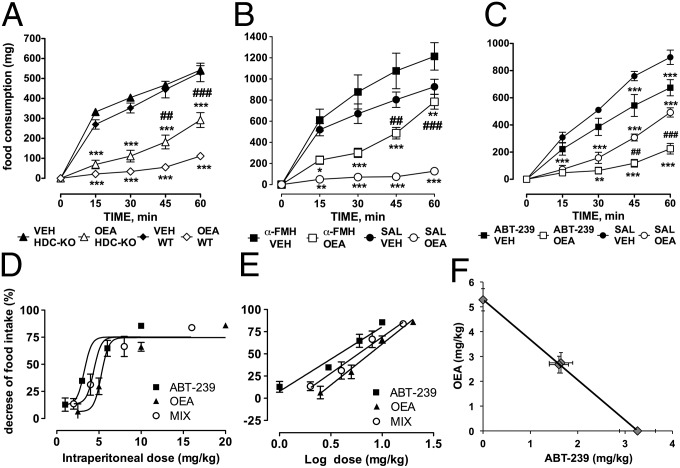Fig. 1.
Interactions between OEA and brain histamine on food consumption. (A). Time course of the effect of systemic administration of OEA (10 mg/kg, i.p.) or vehicle (VEH) on cumulative food intake in 12 h-fasted HDC-KO and WT mice during the lights-on period (0900 h). Each point represents mean ± SEM of 11–8 mice. ***P < 0.001 vs. respective controls. ###P < 0.001; ##P < 0.01 vs. OEA-treated mice WT or HDC-KO mice by two-way ANOVA and Bonferroni’s test. (B) Time course of the effect of α-FMH administration (5 µg; i.c.v.) or saline (SAL) on OEA-suppressed food intake in 12 h-fasted mice. Each point represents mean cumulative food consumption ± SEM of seven to eight mice during the lights-off period (1900 h). ***P < 0.001, **P < 0.01, *P < 0.5 vs. respective controls; ##P < 0.01, #P < 0.05 vs. OEA-treated WT or α-FMH–injected mice; two-way ANOVA and Bonferroni’s test. (C) Increased brain histamine boosts OEA-induced suppression of food intake. Time course of 10 mg/kg OEA and 3 mg/kg ABT-239 effects on cumulative food intake in 12 h-fasted CD1 mice during the lights-on period (0900 h). Each point represents mean ± SEM of seven to eight mice. ***P < 0.001, **P < 0.01, OEA and ABT-239 vs. respective controls; ###P < 0.001; ##P < 0.01, ABT-239/OEA vs. saline/OEA. (D and E) Sigmoidal and log-derived dose–response curves for OEA, ABT-239, and the combined compounds. Each point represents mean cumulative food consumption ±SEM of seven to nine mice expressed as percent food consumption of vehicles. (F) Isobologram for OEA–ABT-239 combined effects on food consumption.

